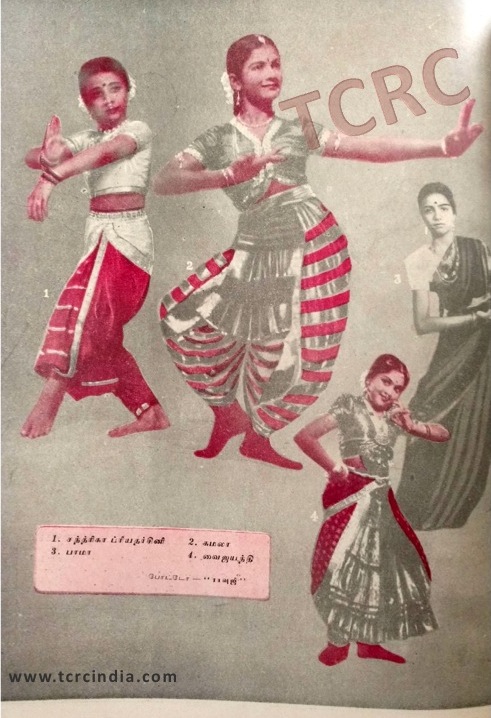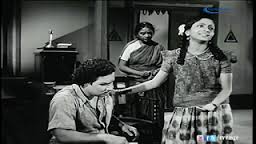By P V Gopalakrishnan
Vyjayanthimala
Vyjayanthimala, born 1936, got a break in an AVM’s Tamil movie, Vazhkai, when she was just fifteen. Director M. V. Raman, spotted the young Vyjayanthi in one of her Bharathanatyam recitals at Gokhale Hall, Madras & recommended to AVM. The movie was a great success and also was remade in Hindi as Bahaar (1951). She acted in a few more Tamil movies like Then Nilavu before moving on to a highly successful career in Hindi movies.
Here is her graceful dance sequence with the popular number “Nanda gopalanodu naan aaduvene” in the film ‘Vazhkkai”. The singer was MLV.
Travancore Sisters:

The Travancore sisters in Ananda Vikatan 1966 PC: From the archives of TCRC
Several noted actors in the past were dancers and had performed on screen. The three sisters ‘Lalitha-Padmini-Ragini’ from Kerala came and ruled the Tamil industry in the forties, popularly known as “Travancore Sisters”.
Born to Thankappan Pillai & Saraswathiyamma in a large Nair family from Thiruvananthapuram, they took to arts at a very early age. Lalitha and Padmini began their training from Kathakali exponent Guru Gopinath.
When the family migrated to Madras they continued their dance training under the great Nattuvanar and Dance Director for films Vuzhavoor Ramaiah Pillai who groomed them to perfection.
The sisters debuted in the film ‘Kannika’ (1947) as dancers in Shiva-Sakthi dance, choreographed by Bharathanatyam Guru Vazhuvoor Ramaiah Pillai. This was the maiden movie produced by Sriramulu Naidu of Pakshiraja Studios, Coimbatore.
The sisters had an active performing career, both as classical dancers and as dancers and actors in South Indian cinema and Hindi cinema as well.
The highlight of “Vanjikottai Valiban” (1958) was the scintillating ‘dance duel’ between Padmini and Vyjayanthimala, which had come to be regarded as one of the best dance sequences in Indian cinema. Bharatanatyam Guru, Dandayudhapani Pillai, choreographed this.
Sai – Subbulakshmi Duo
The dancing duo sisters, Sai & Subbulakshmi were very popular with their brisk movements & performance like a spinning ‘Top’ in early Tamil & Hindi films. This was in quick departure from the earlier dance formats, which were rather slow.
Sai – Subbulakshmi are said to be the off springs of P.A.Periyanayaki , a well-known play back singer of early Tamil films. This duo dancers were very well sought after & mesmerized the cine goers with their captivating dance numbers. Dancing in perfect harmony, the sisters seem to merge effortlessly with the song and the situation and it is easy to see why they were such a draw and came to perform not just in Tamil films but in a series of Hindi films too. They were trained under Muthuswamy Pillai and had tutelage in Kathak from well-established dance masters. They interpreted their dance compositions effortlessly their moves were very fluid. Sai of the duo was also the daughter in law of Actress R. Padma, (the beautiful heroine of “Sabhapathi’ & the then Lux Soap model ) and V.S. Raghavan (Sound Engineer of AVM).
Here is a visual of the Sai-Subbulakshmi duo’s swift dance from the film ‘Malaikannan’.
Kumari Kamala
‘Kumari’ Kamala, as she is generally known even today, is a noted Bharatnatyam dancer and actress of yesteryears. Born in 1934 in a family of artists, where her sisters, Radha and Vasanthi were also dancers, she learnt Kathak from famous Lachhu Maharaj at a tender age. The Tamil film director A.N. Kalyanasundaram Iyer happened to watch her doing a dance concert and debuted her in ‘Valibar Sangam’ (1938) and later Ramanama Mahimai (1939), when she was a baby of four years then. So she was initially known as Baby Kamala. She also appeared as a child artist in Hindi films like Kismet and Ram Rajya in 1943. In Chennai she learnt Bharatnatyam from Muthukumara Pillai and Vazhavoor Ramiah Pillai. She appeared in Tamil movie, Jagathalaprathapan (1944) where she performed the Snake Dance. In her next film Sri Valli (1945), she played double role. Her film Nam Iruvar, based on Bharatnatyam theme made a great impact on audience. In 1953, Kamala performed during her coronation festivities of Queen Elizabeth II.
She has acted in more than 100 films belonging to Tamil, Hindi, Telugu and Kannada
She is the recipient of Padma Bhushan, Kalaimamani & Kendra Sahitya Academy award.Here is a popular dance number ‘Theeratha vilayattu pillai’ from the AVM film “Vedhala Ulagam”.
Waheeda Rahman
The wellknown Hindi’s heroine of yesteryears, Waheeda Rehman, was in fact originally from South, as her family lived in Chengalpattu near Madras. She and her sister learnt Bharatnatyam under Guru Trichunder Meenakshi Sundaram Pillai in Chennai and Guru Jayalaxmi Alva, later in Bombay.

An ad for the film ‘Kaalam MaaRi Pochu in the magazine Pesum Padam PC; From the archives of TCRC
She appeared as a dancer in movies like “Kaalam MaaRi Pochu” (1956), Alibabavum naaRpathu thirudargaLum” (1956). Here is the famous dance sequence of Waheeda in the former film.
Waheeda was proficient in Bharathanatyam. Guru Dutt, who cast her in the Hindi film ‘C.I.D’, spotted her. Then she went on to appear in many of his films. Her pairing with Dev Ananad was very popular.
Rajasulochana
Rajasulochana, born 1934, was a classical dancer and film actress who debuted in Kannada film ‘Gunasagari’ in 1953, since which she acted in more than 250 movies belonging to different languages.
She learnt classical dance forms from various Gurus such as Lalithamma, K. N. Dhandayuthapani Pillai, Vempati Chinna Satyam, Krishnakumar, Vishnu Vysarkar, and Kalamandalam Madhavan. Rajasulochana founded her own Dance School, ‘Pushpanjali Nritya Kala Kendram’ in 1961 at Chennai.
Here is a dance sequence featuring her in the popular song “Vasantha mullai pole vandhu” from the film. ‘Sarangdhara’.
Down the time line, there were more trained & accomplished classical dancers who were also actors in Tamil Cinema such as E.V.Saroja, Jayalalitha, and VennirAadai Nirmala.
Tamil Cinema continues to feature dances to date, but of different genres to suit the modern tastes of cine goers. However, Dance as an Art Form, no doubt, continues to be patronized by the Films.
























